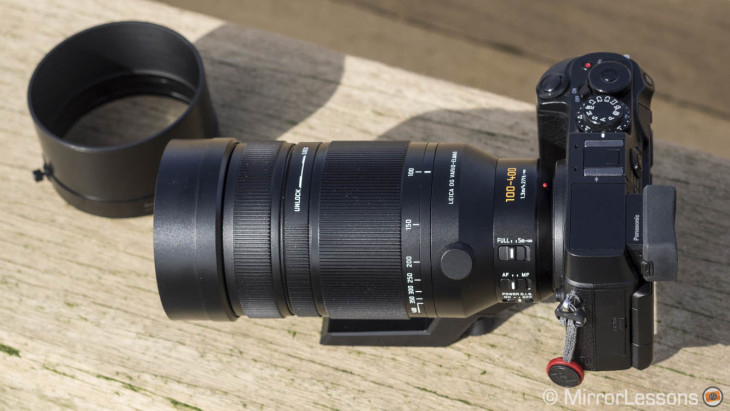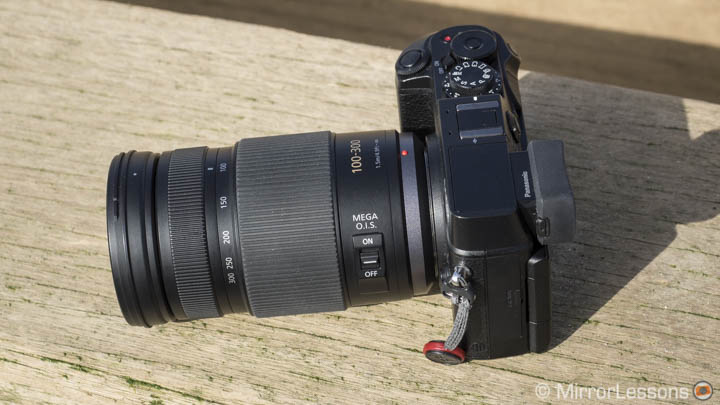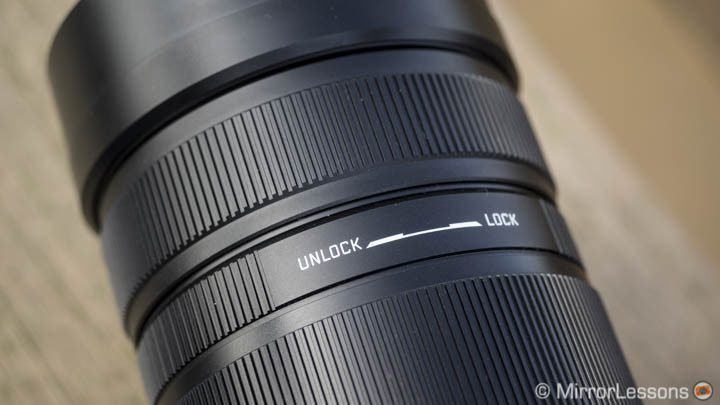As a follow up to our Panasonic/Leica 100-400mm f/4-6.3 review that we published yesterday, here is a comparison with another popular super zoom lens for Micro Four Thirds which is perhaps its most natural competitor: the Lumix G 100-300mm f/4-5.6.
The recent 100-400mm is the fourth super telephoto zoom lens (past 150mm) designed for the m4/3 system. It is also the first premium lens found in this category (excluding of course the Olympus 300mm f/4 Pro which is a prime lens).
The five year gap between the two Panasonic lenses cannot be ignored: while the 100-400mm is brand new, the 100-300mm, which was announced in September 2010, is more than 5 years old. This also means there is a substantial difference in price: the 100-300mm can now be found for an average of $500 while the new 100-400mm costs more than three times that amount.
If you read my 100-400mm review, you’ll know that it left a very positive impression on me. But given the price difference, you might wonder whether the new lens is worth the extra money.
Is the new 100-400mm that much better than the 100-300mm? Let’s find out!

Click on the image to open the full res version.

Click on the image to open the full res version.
[toc heading_levels=”3″]
Ethics statement: The two lenses were loaned to us so that we could conduct our full reviews and comparisons. We were not asked to write anything about these lenses, nor were we provided any other compensation of any kind. Within the article, there are affiliate links. If you decided to buy something after clicking the link, we will receive a small commission. Don’t worry – prices remain the same for you. To know more about our ethics, you can visit our full disclosure page. Thank you!
Video comparison
Below you can also watch a video version of the comparison between the two lenses.
Main Specs


Both lenses have been manufactured by Panasonic for the Micro Four Thirds system. Although the zoom range is similar, the two lenses are in fact very different.
The 100-400mm f/4-6.3 was designed by Leica in partnership with Panasonic. The lens has a metal barrel, and is weather sealed. It features the Power O.I.S. optical stabilisation and is compatible with the 240fps AF drive and the Lumix GX8 Dual IS system.
The 100-300mm f/4-5.6 is 5 years old, is smaller and lighter and isn’t weather sealed. The barrel is made of robust plastic and the lens is a Panasonic design. It features the Mega O.I.S. and is not compatible with Dual IS.
Leica DG Vario-Elmar 100-400mm f/4-6.3 ASPH
- Focal length: 100-400mm
- Focal length (equiv. 35mm): 200-800mm
- Maximum aperture: 4
- Minimum aperture: 6.3
- Number of aperture blades: 9 circular aperture diaphragm
- Angle of view: 12 ‑ 3.1°
- Closest focusing distance: 130cm
- Lens configuration: 20 elements / 13 groups
- Special elements: 1 Aspherical ED, 1 EUD, 2 ED elements
- Lens surface coating: None
- Maximum image magnification: 0.25x / 0.5x (35 mm camera equivalent)
- Optical Image Stabilizer: Yes (POWER O.I.S.)
- Dimensions: φ83, 171.5 mm
- Filter diamater: 72mm
- Weight: 985g (excluding lens cap, lens rear cap, lens hood and tripod mount)
Lumix G Vario 100-300mm f/4-5.6
- Focal length: 100-300mm
- Focal length (equiv. 35mm): 200-600mm
- Maximum aperture: 4
- Minimum aperture: 5.6
- Number of aperture blades: 7 circular aperture diaphragm
- Angle of view: 12 ‑ 4.1°
- Closest focusing distance: 150cm
- Lens configuration: 17 elements / 12 groups
- Special elements: 1 ED element
- Lens surface coating: None
- Maximum image magnification: 0.21x / 0.42x (35 mm camera equivalent)
- Optical Image Stabilizer: Yes (MEGA O.I.S.)
- Dimensions: φ73.6, 126 mm
- Filter diamater: 67mm
- Weight: 520g (excluding lens cap, lens rear cap, lens hood and tripod mount)
Design and ease of use
The first main difference between these two lenses concerns the size and build quality.

The 100-400mm is larger, longer and heavier (almost 1kg). It features a premium metal finish (including the supplied hood). It is weather sealed against dust and water.

The 100-300mm is mostly made of plastic on the outside. The zoom ring is covered with rubber. It comes with a plastic hood and the lens is not weather sealed. It is almost half the weight (520g) and is also smaller as you can see from the images.
Both lenses lack an internal zoom mechanism so they protrude when you zoom in to the longest focal lengths. As you can see, the 100-400mm is once again longer when used at 300mm and 400mm.
[twentytwenty]


[/twentytwenty]
[twentytwenty]


[/twentytwenty]
The 100-400mm is more comfortable to use with a high end Micro Four Thirds product like the Panasonic GH4, GX8 or Olympus OM-D E-M1.
The 100-300mm, being smaller, has the advantage of being easier to use on smaller Micro Four Thirds cameras like the OM-D E-M10 for example.
The 100-400mm also has some unique features that make it easier to use for advanced photographers.
We find three switches to limit the focus distance, choose between AF and MF and activate or deactivate the optical stabilisation. There is a lock ring to lock the zoom ring at any focal length you wish. The hood is positioned on a sliding ring to extend it more if needed. The focus ring is smooth and precise to use.


The 100-300mm only has the O.I.S. switch on the side. On the sample I tested the focus ring was stiffer than I’d like it to be and that can be uncomfortable when manual focusing in video mode.

Finally the 100-400mm has a tripod collar with a clever mechanism that allows you to remove it easily and rotate it to portrait orientation without changing the position of the switches on the side.
Note that the tripod collar on the 100-400mm is also needed because of the weight and length of the lens. The 100-300mm, being smaller and more compact, has no need for a tripod collar.
Optical quality
The 100-400mm has an equivalent field of view of 200-800mm according to 35mm format equivalence. The lens has been designed in partnership with Leica.
The 100-300mm gives you a 200-600mm equivalent focal range. It is a Panasonic design.
In terms of angle of view, both lenses can give you similar results in the real world. Of course the extra 100mm of the Pana/Leica lens are a welcome bonus especially for wildlife photography. The angle of view changes by only 1 degree between 300mm and 400mm (from 4.1° to 3.1°) but that difference can be of help in many situations once you get used to framing with an 800mm equivalent focal length. (Believe me it takes some time!)
Slide between the two images below to see the difference between 300mm and 400mm from an average distance of 5m.
[twentytwenty]


[/twentytwenty]
The first set of comparison shots show the performance of these two lenses at 300mm, which is the longest focal length of the 100-300mm (the Leica lens of course can go up to 400mm). Note that both lenses have the same fastest aperture for the following focal lengths:
- 100mm: f/4
- 200mm: f/5
- 300mm: f/5.6
So the slowest aperture of f/6.3 only relates to the longest focal length of the 100-400mm.
The results are quite clear: the 100-400mm is sharper at f/5.6 and f/8.
The performance is slightly closer from f/11 but then diffraction also starts to play a role. Overall the 100-400mm suffers less from diffraction and the difference is visible even at f/22.

Click on the image to open the full res version.

Click on the image to open the full res version.
[twentytwenty]


[/twentytwenty]

Click on the image to open the full res version.

Click on the image to open the full res version.
[twentytwenty]


[/twentytwenty]
Note: you can check out a full res image gallery shot at 300mm and all apertures here.
The difference in sharpness remains the same for longer distances. This becomes an important factor for wildlife photography as animals are likely to be distant from you. As you can see from the two images below, the 100-400mm retains more sharpness.

Click on the image to open the full res version.

Click on the image to open the full res version.
[twentytwenty]


[/twentytwenty]
Note: the two pictures above were taken with two different cameras at a slightly different focal length (the latter is a simple mistake). The GX8 picture has slightly more resolution. However as shown in our GX8 vs E-M1 comparison, the differences between the 20MP and 16MP sensor are minimal, so I still find the two images a decent real world example.
Of course you have the extra reach with the 100-400mm. In my full review of the lens I found the performance at 400mm to be slightly softer than at 300mm. However, with the same composition, the Pana/Leica lens is still sharper at 400mm than the Lumix G 100-300mm at 300mm.
At 200mm, the advantage of the 100-400mm remains relevant at f/5. It is slightly sharper at f/8. From f/11 the 100-400mm maintains a small advantage up to f/22.

Click on the image to open the full res version.

Click on the image to open the full res version.
Note: you can check out a full res image gallery shot at 200mm and all apertures here.
At 100mm, the performance at f/4 and f/5.6 is much closer and surprisingly at f/8 the 100-300mm seems to be slightly better. From f/11 the performance remains basically identical.

Click on the image to open the full res version.

Click on the image to open the full res version.
[twentytwenty]


[/twentytwenty]
The 100-400mm can focus as close as 1.3m at any focal length. As a result at 400mm you can get quite close to your subject (0.5x magnification with 35mm format equivalence).
The 100-300mm can focus as close as 1.5m and as you can see from the image below, the magnification factor is slightly larger (0.42x/35mm format).

Click on the image to open the full res version.

Click on the image to open the full res version.
Concerning the bokeh, both lenses produce a very similar rendering despite having different diaphragm blades for the aperture (9 for the 100-400mm, 7 for the 100-300mm).
This is interesting because in my 100-400mm review I stated that the lens’ bokeh has some character despite not being perfect. Well, when I compare it to the 100-300mm, there aren’t many differences. We can distinguish some double lines and hard edges from both but overall the performance is very similar.

Click on the image to open the full res version.

Click on the image to open the full res version.

Click on the image to open the full res version.

Click on the image to open the full res version.
Both lenses can suffer from purple veiling flare and the 100-400mm can also display some greenish ghost flare.


The 100-400mm handles chromatic aberration almost perfectly. Indeed there is hardly a trace of it. The 100-300mm suffers more but chromatic aberration can easily be eliminated in a RAW developer software.

Click on the image to open the full res version.

Click on the image to open the full res version.
[twentytwenty]


[/twentytwenty]
Finally, the 100-400mm has almost no vignetting or distortion worth mentioning. The 100-300mm is slightly weaker in this regard but it can once again be easily corrected in post production.
Autofocus
Here comes another relevant difference between these two lenses especially if you use them on a Panasonic body that is compatible with the 240fps AF Drive like the Lumix GX8.
In Single AF the difference is less noticeable. Both lenses are fast and accurate on Lumix and Olympus bodies. I would say that the 100-400mm is slightly faster because of the most recent AF motor technology. The 100-300mm also makes more noise when focusing while the 100-400mm is completely silent.

Click on the image to open the full res version.

Click on the image to open the full res version.
In Continuous AF, there is a substantial difference.
I ran a simple test with both lenses below featuring the same subject moving at the same speed (thanks Heather!). Because of the AF drive compatibility, the 100-400mm allows you to take more shots in a burst. I used the M speed with both lenses and set Focus priority. Not only did I get more shots with the 100-400mm because the lens focuses faster but I also found the AF performance more consistent and accurate.

Click on the image to open the entire sequence.

Click on the image to open the entire sequence.
I also tested both lenses with birds in flight. Overall my conclusions are very similar. With the 100-400mm I had more interesting results and more constant behaviour in terms of both sharpness and AF accuracy.
With the E-M1, the performance of the two lenses is closer but I still find the 100-400mm faster and more accurate. Once again the difference can be substantial when shooting in Continuous AF and high burst mode.

Click on the image to open the full res version.

Click on the image to open the full res version.

Click on the image to open the full res version.

Click on the image to open the full res version.
Optical stabilisation
The 100-400mm features the latest generation of Panasonic’s optical stabilisation (Power O.I.S.).
The 100-300mm has Mega O.I.S which is an older image stabilisation system.
In my findings, there is more or less 1 stop of compensation difference between the two lenses. I used the E-M1 for my test by activating OIS only.
With the 100-400mm, I managed to record an almost perfectly sharp shot at 1/10s at 300mm and 1/15s at 400mm.
The sharpest shot I was able to achieve with the 100-300mm was at 1/25s.

Click on the image to open the full res version.

Click on the image to open the full res version.
The 100-400mm is also compatible with the Dual IS system of the Panasonic GX8 where both the sensor and optical stabilisation are used.
As I stated in my 100-400mm review, the Dual IS system doesn’t give you a substantial advantage at 300mm or 400mm. The sharpest result I got was at 1/15s which matches the result I got with the Power O.I.S. alone. I believe the GX8 prioritises the lens O.I.S. at extreme focal lengths.
Of course for a real world shoot it is better to use faster shutter speeds to ensure sharpness even with static subjects. With the 100-400mm my advice is to use at least 1/200s with the longest focal lengths and 1/400s with the 100-300mm. If you have enough light, use an even faster speed.

Click on the image to open the full res version.

Click on the image to open the full res version.
For video
Both lenses work well for 4K shooting and as expected, the 100-400mm gives you slightly sharper results once more. As stated before, the AF motor is more silent on the 100-400mm and the focus ring is smoother if you prefer manual focus.
The O.I.S. on both lenses can produce some jittering which, depending on the situation, can be quite unpleasant especially if your shots are very static and you are shooting at the longest focal lengths.
The 100-400mm Power O.I.S. is more effective but with both lenses my advice is to use a monopod at the very least. The best results will be achieved with a proper video tripod and a fluid head (and OIS turned off) as every little movement (including some soft wind) can produce shaky footage at 300mm and 400mm.
Note: you can watch some video footage shot with the two lenses side by side in our video comparison at the beginning of this article.
Conclusion
It is clear that the new 100-400mm f/4-6.3 has many advantages in part because of the 5 year gap between it and the 100-300mm f/4-5.6. The Pana/Leica lens is sharper, focuses faster and has a more effective optical stabilisation system. The higher price is also justified by the more robust weather-sealed metal build.
That said, the 100-300mm is anything but a “loser” in this comparison. Yes, it is softer at 200mm and 300mm but if we consider that it was announced in 2010, it stands up to its sibling very well.

What’s more, the more affordable price is a big advantage for someone who wants to start using a super telephoto lens and gather enough experience before investing in something more expensive. Olympus users can also consider the 75-300mm f/4.8-6.7 but the latter has a slower aperture and that can mean raising you ISO higher for birds in flight.
I would also consider the lighter and smaller size of the 100-300mm an advantage if you own a smaller m4/3 camera (GX7, E-M10, Pen series). The combination will certainly be more balanced.

Of course if optical quality is your main concern, the 100-400mm is definitely better. It is a lens designed for advanced photographers who want the versatility of a zoom lens and the performance of pro optics. The 100-400mm delivers exactly that.
Choose the Panasonic 100-400mm f/4-6.3 if:
- You want better optical performance (more sharpness)
- More effective optical stabilisation
- Faster AF motor
- Convenient buttons on the side and a tripod mount
- Weather sealing
Choose the Panasonic 100-300mm f/4-5.6 if:
- You are on a budget
- You want a smaller and lighter lens
Check price of the Panasonic 100-400mm on
Check price of the Panasonic 100-300mm on


